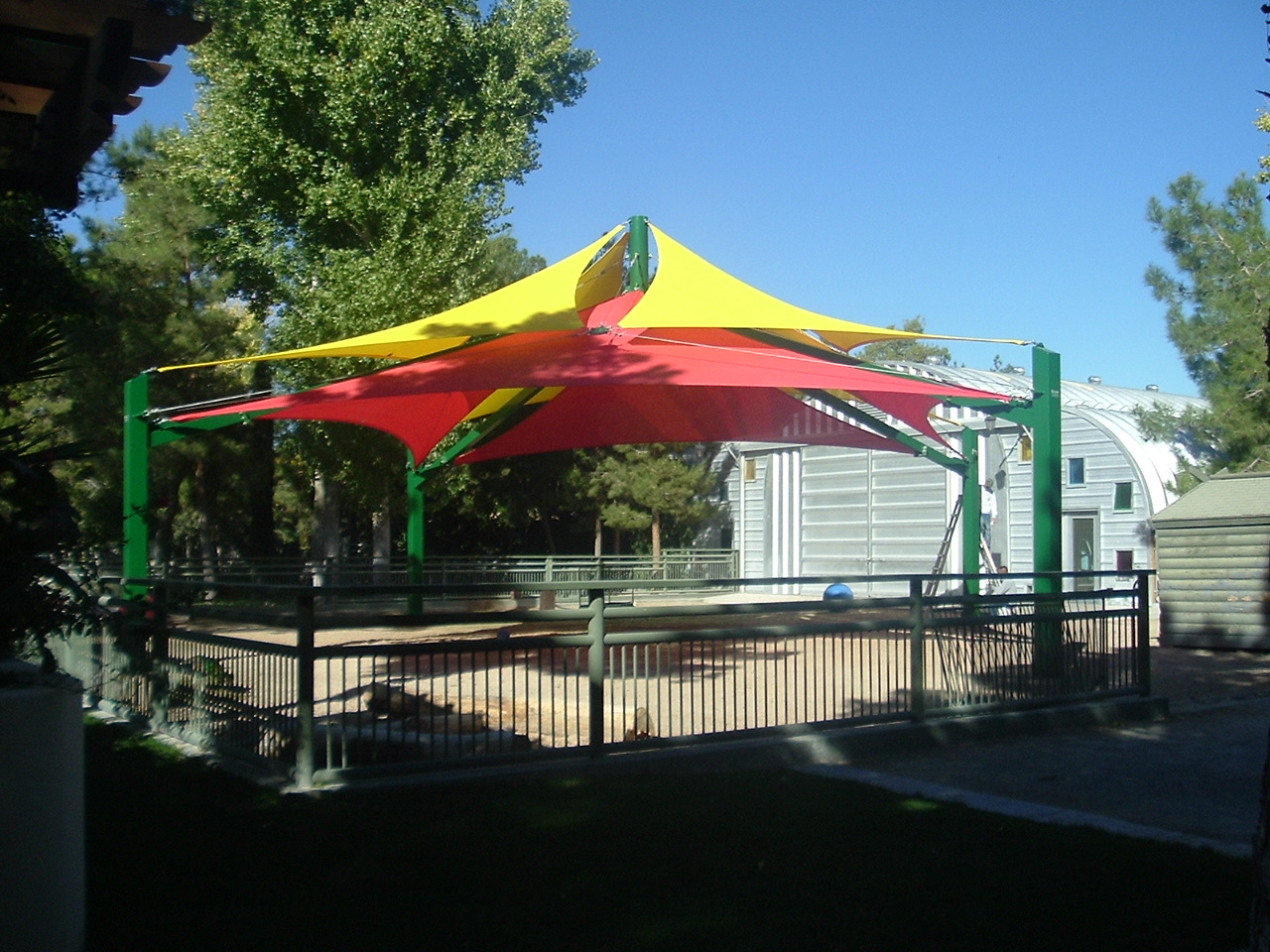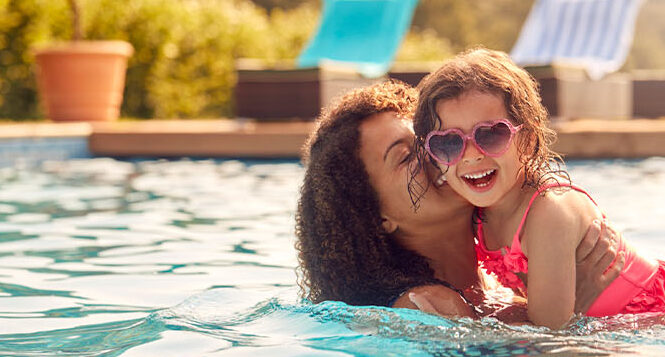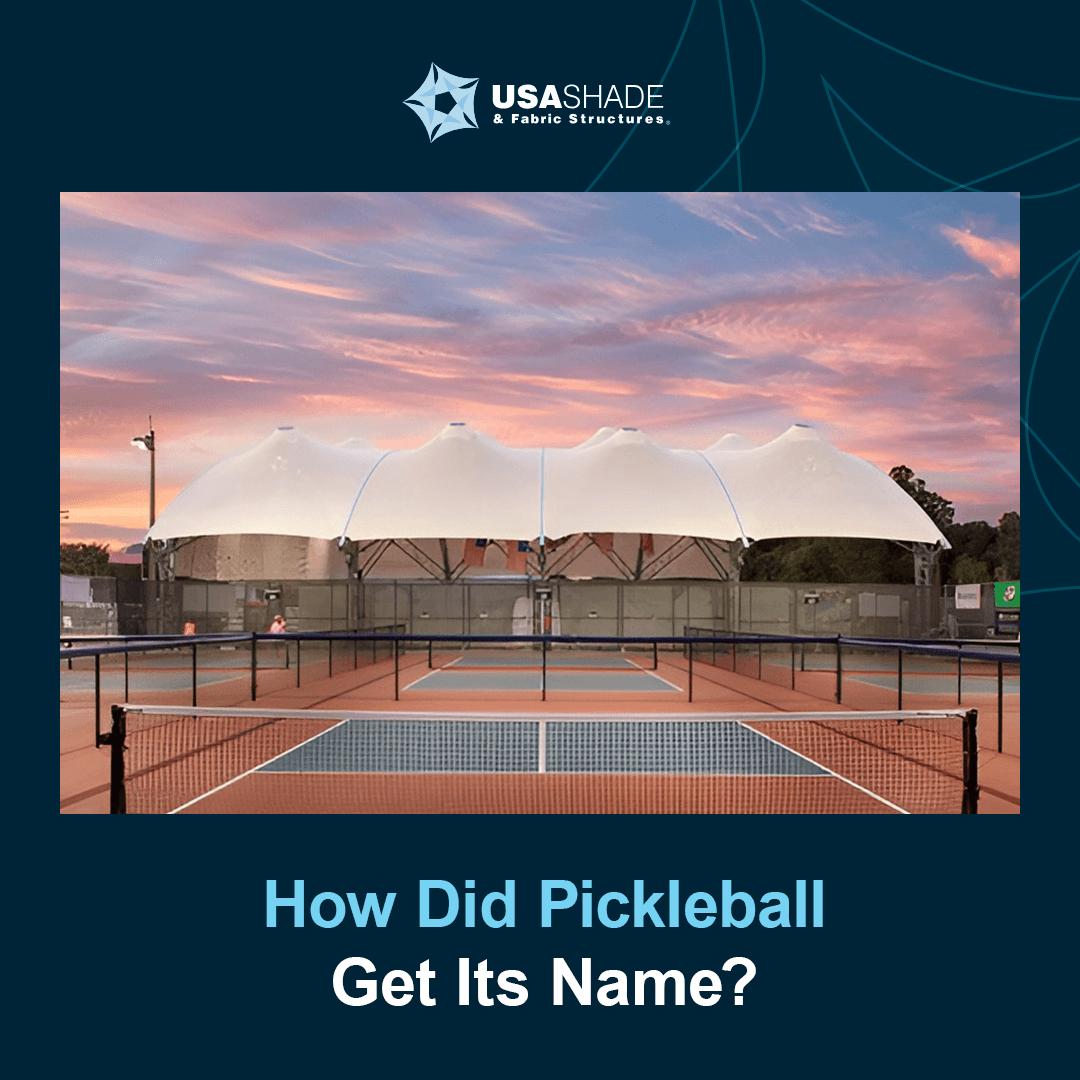Many people want to live in a neighborhood with a swimming pool — if your homeowners association (HOA) has one, you know how much value it adds. While you and your neighbors enjoy cooling down in the water on a hot summer day, there are numerous obligations that HOA board members must follow.
Continue reading to learn more about how to maintain your HOA pool and the benefits it can bring to your community.
The Benefits of HOA Pools
While a community pool is an excellent way to beat the heat, that’s not the only thing that makes it a great outdoor activity. HOA pools offer numerous benefits that make them an excellent investment.
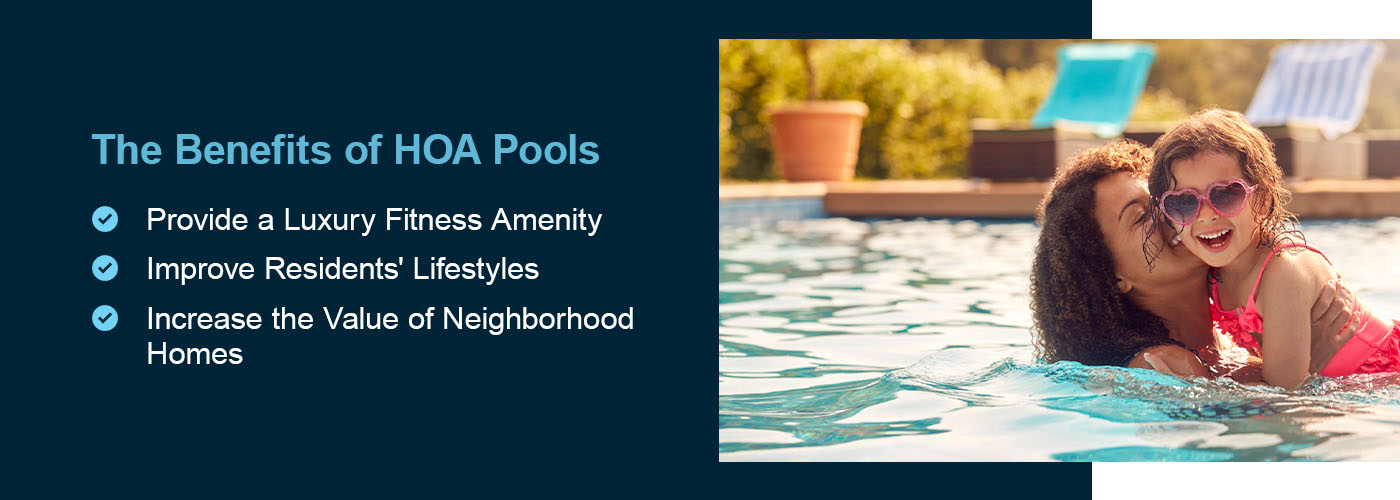

Provide a Luxury Fitness Amenity
According to Strategic Research Associates, millennials’ fitness habits show that they’re more likely to opt for cheaper forms of exercise — like working out at home or doing outdoor activities — than pay for a gym membership. Additionally, older millennials made up around 25% of U.S. homebuyers in 2021, making them the generation with the highest percentage of homebuyers in the country.
A community pool creates an opportunity for HOAs to install a luxury fitness amenity that will appeal to its residents. Your HOA can maximize its investment with a few swimming instructors, multilane competitive pools and fully equipped locker rooms for the ultimate resident luxury.
Improve Residents’ Lifestyles
Installing an HOA pool is a perfect opportunity to appeal to all types of residents. A community pool offers a fun-for-all summertime activity, and residents of all ages will enjoy the benefit of having a swimming pool in their neighborhood.
Swimming is an excellent way for the whole community to get in shape and improve their overall health and well-being:
- All residents: Swimming is a full-body workout that keeps people sweat-free, putting community pools in an ideal position to rise above the usual two-bike and treadmill gyms. It provides low-impact aerobic exercise that engages the core, back, legs, glutes and arms, while the water resistance helps improve endurance, strength, balance and flexibility. Few other workouts can provide that type of outcome in a single session.
- Older residents: As homeowners in a community age, they may develop health conditions and physical limitations that need specialized care and attention. Swimming is an excellent aerobic exercise and can help older community members manage their rheumatoid arthritis and reduce their blood pressure, which can lead to strokes and heart disease.
- Pregnant residents: As a low-impact exercise, swimming is a safe form of exercise for pregnant residents. The water’s buoyancy can help relieve joint discomfort while pregnant residents maintain their endurance and muscle strength.
Increase the Value of Neighborhood Homes
Well-maintained amenities suggest a more secure, cleaner HOA-governed neighborhood. Depending on the local market and the general maintenance, amenities generally provide additional appeal to the list when selling a home. Homes, townhouses, apartments and condos with attractive amenities like a community swimming pool can increase individual property values.
Outside of aesthetics, the community pool can work to everyone’s advantage regarding what each property is worth. An HOA pool is a tempting oasis in high-temperature areas like California, Texas and Arizona. A well-maintained in-ground neighborhood pool serves as a central site for community exercise and enjoyment and may even boost the resale value of individual residences.
HOA Pool Maintenance and Safety Tips
The responsibilities and management of an HOA pool will fall to members and community managers. A proactive approach ensures a secure, well-maintained community pool environment.
Safety measures are crucial to ensure a fun-for-all and secure neighborhood swimming pool. Make safety the top priority and apply the following HOA pool maintenance tips to the community’s swimming pool.
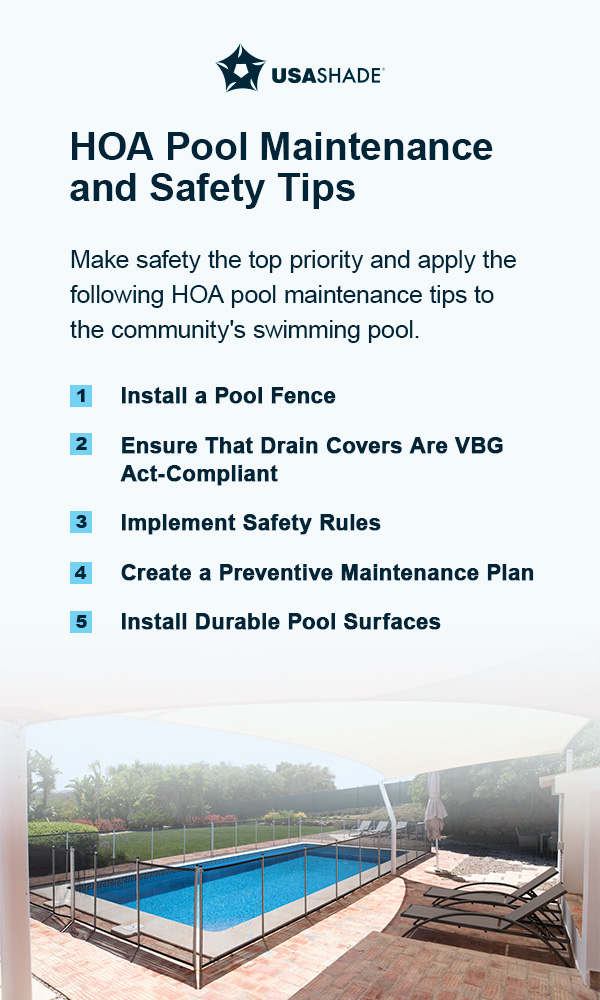

1. Install a Pool Fence
Installing a fence around a community swimming pool will add a layer of protection for unsupervised children, pets and people who can’t swim. A self-closing and self-latching gate can help keep children and pets secure, providing additional peace of mind for parents and other adults.
In addition to guarding the community’s safety, a pool fence also contributes to its security. A pool can attract unauthorized individuals from outside the community, especially if they don’t have their own swimming pool. The expense of installing a pool fence is well worth the protection of the neighborhood.
It’s critical for HOA members to familiarise themselves with any area-specific pool fence standards and regulations and hire a professional pool fencing business. Some insurance companies may require pool owners to build a fence to follow safety measures. Additionally, adding a pool fence may increase individual property values by showing that the HOA members and residents take safety and security seriously.
2. Ensure That Drain Covers Are VBG Act-Compliant
Verifying that your HOA pool’s drain covers comply with the Virginia Graeme Baker Pool and Spa Safety (VGB) Act is vital. The VGB Act requires safety equipment like anti-entrapment drain covers in public spas and pools.
Secure and well-maintained drain covers help avoid entrapment hazards that can arise due to the strong suction power of a water vortex. Flat drain covers are easy to cover with a body part, while a curved drain cover is considerably more challenging to envelop. The U.S. Consumer Product Safety Commission has visual examples of different drain types for reference.
Drain covers also have a limited life span and require periodic replacement. How often your HOA replaces them will depend on the manufacturer — the life span will be clearly stamped or branded on all plastic drain covers, spa suction outlet covers and skimmer equalizer covers. Part of your HOA pool maintenance checklist should be to check the drain covers’ life span stamps and schedule a date to replace them.
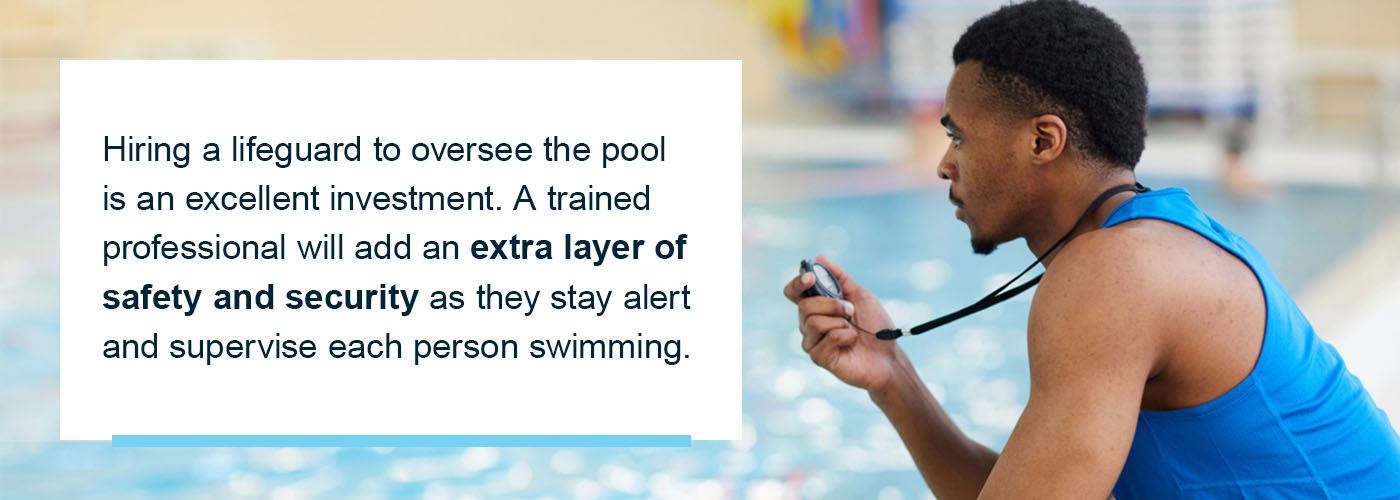

3. Implement Safety Rules
It’s essential to educate residents of all ages about pool safety. HOA members have the authority to ensure that everyone is out of harm’s way when swimming and playing in an HOA pool. Pool safety rules help protect individuals and the community as a whole. They can cover requirements before residents enter the water and what behavior is allowed in the community pool.
The Centers for Disease Control and Prevention (CDC) provides simple steps for healthy swimming that your HOA can use as a guide. For example, those learning to swim should:
- Always have supervision.
- Stay in shallow water.
- Wear safety equipment to keep them afloat.
Hiring a lifeguard to oversee the pool is an excellent investment. A trained professional will add an extra layer of safety and security as they stay alert and supervise each person swimming.
4. Create a Preventive Maintenance Plan
Preventive pool maintenance can extend the life of all pool components, from the skimmer to the pumps and motors. Additionally, repairing or replacing an item before it fails will help avoid pool downtime and costly emergency repairs.
Preventive maintenance consists of daily, weekly, monthly and yearly tasks to ensure the health of your HOA pool. A pool maintenance checklist can help keep track of what your HOA needs to do and how often they need to do them. Create a list of pool maintenance tasks and sort them by frequency. Scheduling them into a shared calendar can help ensure everyone knows what tasks they need to do and when.
Here are a few examples of tasks your HOA can add to a proactive maintenance checklist:
- Measure water levels
- Check the baskets for debris
- Test the chemical levels
- Add necessary chemicals
- Tighten ladder or slide bolts
- Deep clean the filter
- Replace the drain cover
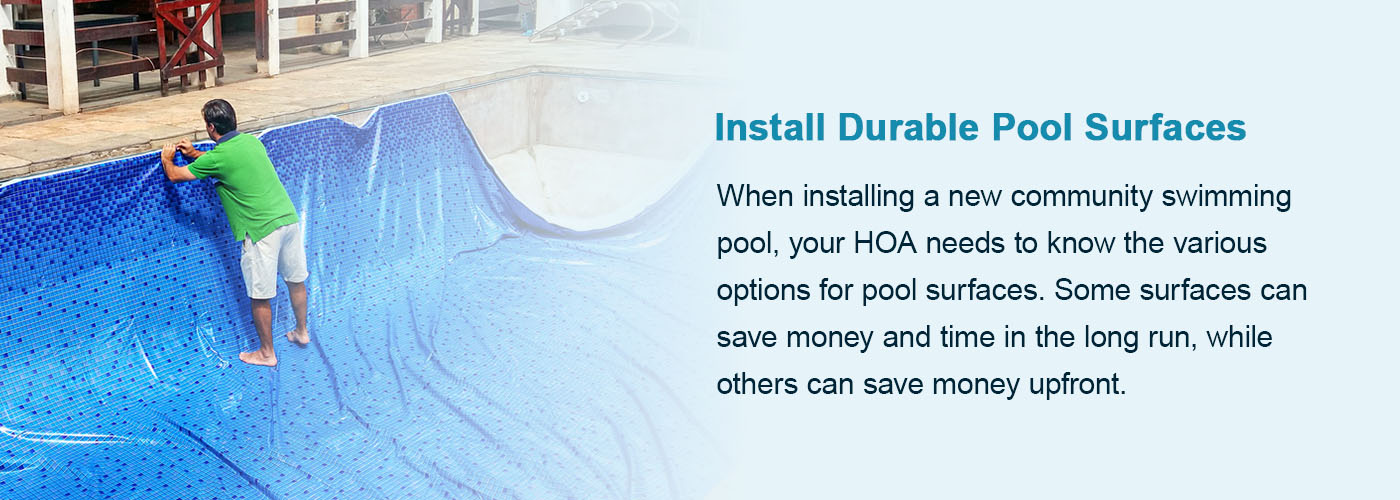

5. Install Durable Pool Surfaces
When installing a new community swimming pool, your HOA needs to know the various options for pool surfaces. Some surfaces can save money and time in the long run, while others can save money upfront. Your HOA can also add pool finishes like plaster, aggregate and tile to make a pool surface more aesthetically pleasing.
In addition to cleaning pool surfaces directly, maintaining balanced pool water chemistry is essential for swimmer protection and the pool surface’s longevity. Unbalanced water chemistry may cause cloudy water, swimmer discomfort and damage to a pool’s surface. Neglected pool surfaces can soon become abrasive, causing scratches or injury to swimmers.
6 Tips for HOA Pool Management
While an HOA pool brings many benefits to a community, it also brings many responsibilities. Your HOA will have maintenance and safety considerations, seasonal challenges and even regulatory points to consider while managing a community pool.
1. Determine if It Needs to Be ADA Compliant
When installing or upgrading a community pool, your HOA will need to know if the Americans with Disabilities Act (ADA) standards for accessible design apply. These standards are a set of minimum requirements for new and existing pools and spas that meet the definition of public accommodation.
A pool may not need to comply with ADA standards in certain scenarios. For example, an HOA that only allows members and their visitors access to the swimming pool and amenities may not have to meet accessible design standards. However, the neighborhood is bound to include physically challenged people, and the HOA may need to take special precautions to keep the pool accessible for them.
It’s best to research the requirements and consult an attorney to establish whether your HOA pool must comply with ADA standards.
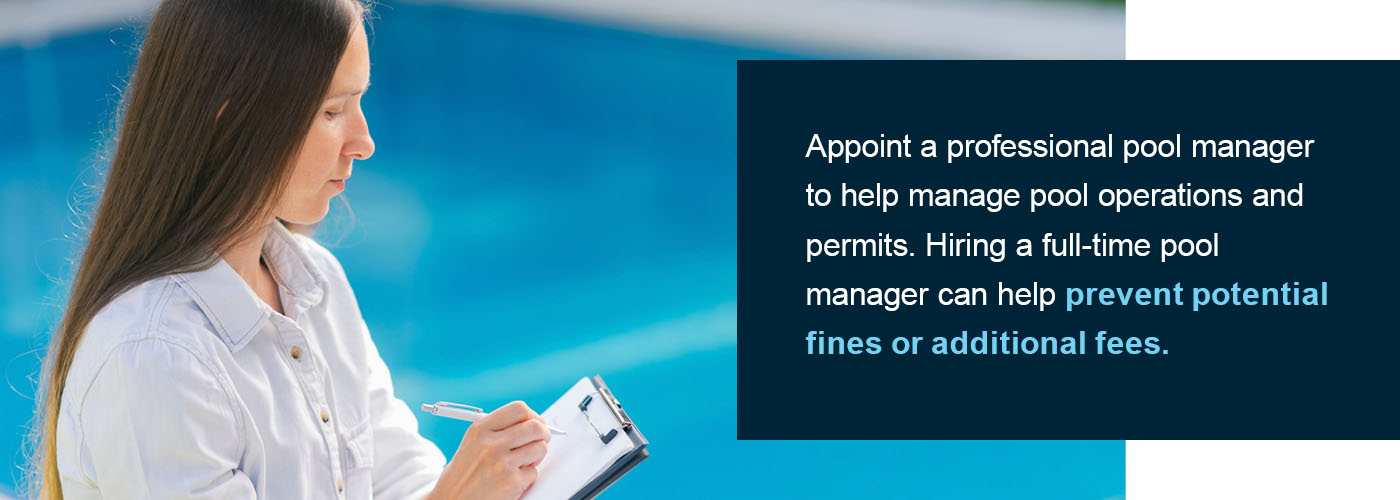

2. Hire a Professional Pool Manager
Appoint a professional pool manager to help manage pool operations and permits. An HOA pool may require an operating permit — the cost will vary according to the neighborhood’s location — and other necessary paperwork, like lifeguard certificates. Hiring a full-time pool manager can help prevent potential fines or additional fees.
3. Audit Pool Equipment Before the Pool Opens
It’s crucial to perform pool equipment audits before opening the community pool. Have a checklist ready with a list of essential pool equipment and furniture, like:
- Skimmer nets
- Vacuum heads
- Baskets
- Ladders
- Chlorinators
- Loungers
- Umbrellas
- Chairs
- Tables
Keeping a list of pool equipment will help keep track of what the pool currently has in stock and where. Audits can also help your HOA identify which equipment to repair or replace for the next pool season.
Always store pool essentials away in a closed, dry, elevated space away from chemicals.
4. Include Automated Chemical Controls
A properly configured automated chemical control system will simplify the process of preparing a pool for the swimming season. Save time by automating each component of the pool chemical system, including pumps, purifiers, tanks and the heating system.
Your HOA can opt for a variety of chemical control systems. For example, an automatic pool cover can reduce chemical, electricity and water costs. Pool covers help limit the use of pool chemicals by limiting the amount of water that evaporates while the pool is unoccupied. Automatic pool covers also save time otherwise spent manually putting a cover in place.
5. Make Sure People Know and Follow the Rules
A simple list of rules is essential to create a peaceful environment. Community members’ health and safety should be an HOA’s priority, so ensure each resident knows the pool rules and why they’re necessary.
A set of safety rules is critically important if any residents are young, older adults or pregnant. Designated areas for these members can help cultivate harmony in the community pool. A professional pool manager or lifeguard can help ensure the community follows pool rules and regulations, creating a secure and harmonious environment.
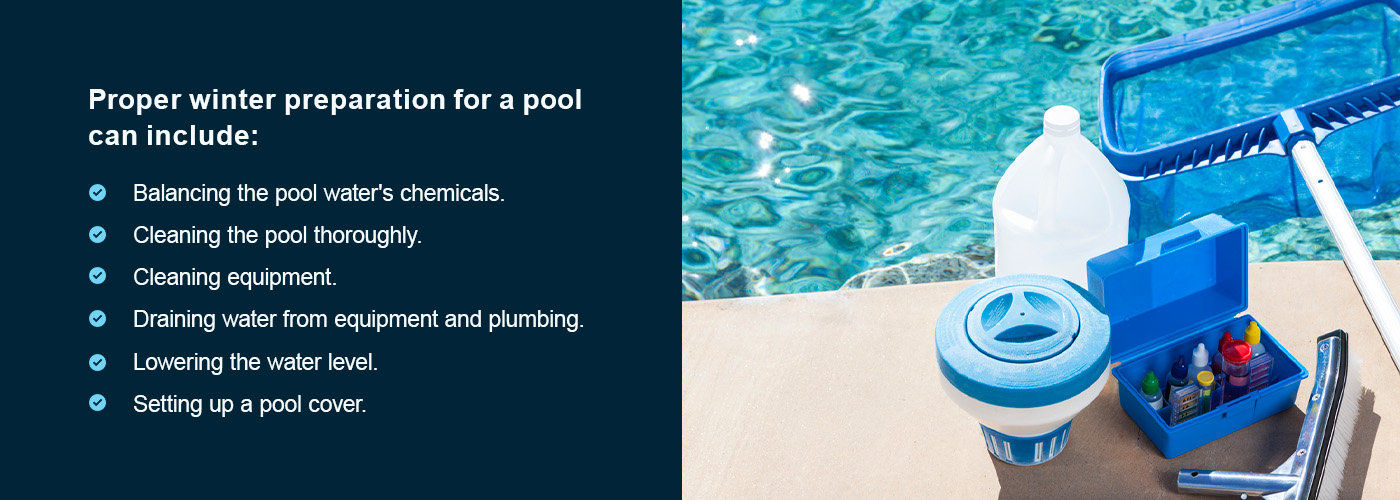

6. Prepare Your Pool for the Winter Season
How your HOA cares for the pool during the colder seasons is as essential as its care during warmer weather. While the process can vary based on geographical location, maintenance routine and pool type, winterizing always has the same goal. The steps your HOA takes will help protect the equipment, plumbing, interior finish, structure and tiling from damage caused by freezing temperatures.
Proper winter preparation for a pool can include:
- Balancing the pool water’s chemicals.
- Cleaning the pool thoroughly.
- Cleaning equipment.
- Draining water from equipment and plumbing.
- Lowering the water level.
- Setting up a pool cover.
How much your HOA lowers the water levels will depend on the regional climate — like expected rain, snow and snow melt — and the type of pool cover they use. It’s generally best to lower the water level to about six inches below the skimmers and return pipes to prevent them from cracking due to freezing temperatures.
Using algaecide or a winterizing chemical to treat the water will help keep it clear over the winter and ready for use when the warmer months approach.
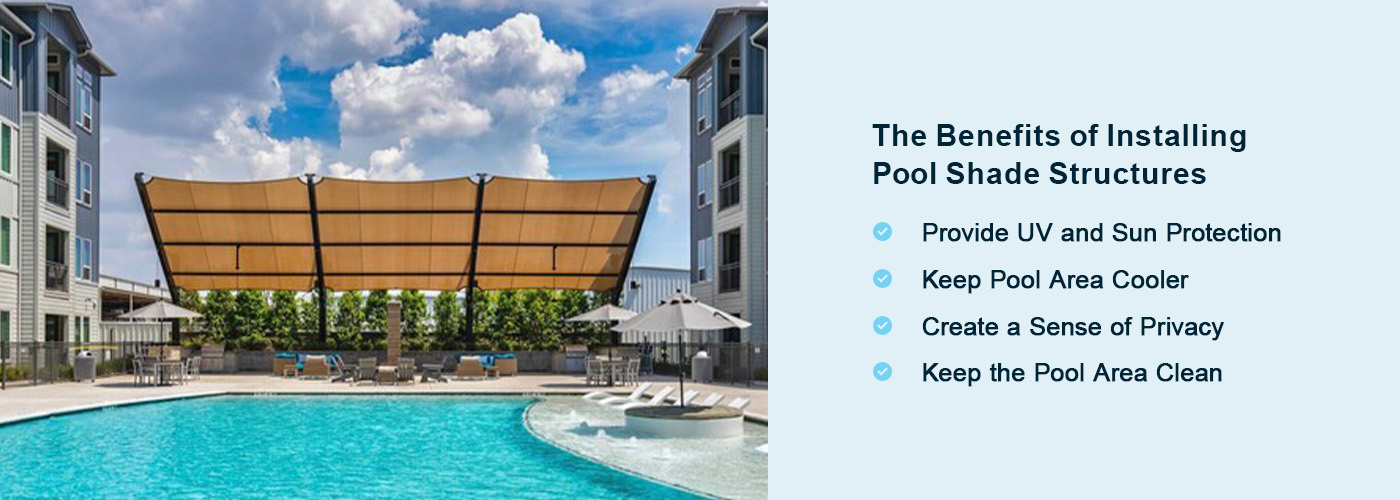

The Benefits of Installing Pool Shade Structures
Management and maintenance of a community swimming pool extend even further — factors like shading also play a role. Sun exposure can impact multiple areas of a community pool, and installing various shade structures can limit the risk of sun damage and make pool time more enjoyable.
Pool shade structures protect pool-goers while keeping the pool and the surrounding area comfortable. Different shade structures offer unique features for any project, but some of their benefits are universal.
Provide UV and Sun Protection
Spending time outdoors is a fantastic way to reduce stress, be physically active and get vitamin D. Outdoor community pools are a great way to do just that. Time can fly when residents are having fun — the next thing they know, they’ve spent hours baking in the sun’s UV rays. In addition to reducing sunburn, protecting residents from harmful UV rays can help protect those with sensitive skin or skin conditions.
There are numerous ways in which individuals can protect themselves from the sun. They can wear clothing to cover exposed skin, hats to shade their face and sunglasses to protect their eyes from UV rays. Of course, when they swim, all these layers will come off.
They can also apply sunscreen before and after swimming to block UVA and UVB rays. However, many people forget to reapply their sunscreen as it wears off.
That’s where shading comes in. Installing UV-protective pool shade structures around the pool area creates a protective barrier between pool-goers and the sun without blocking any of the sun’s vibrance and warmth.
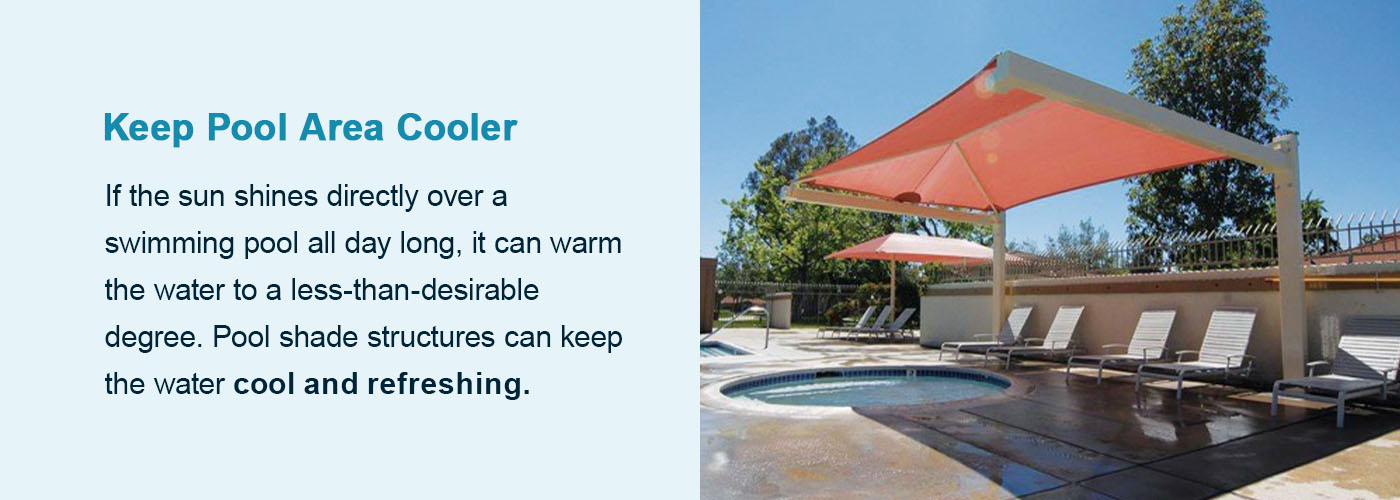

Keep Pool Area Cooler
Along with UV protection, pool shade structures can keep the pool cooler. If the sun shines directly over a swimming pool all day long, it can warm the water to a less-than-desirable degree. Pool shade structures can keep the water cool and refreshing.
Imagine a resident heading to your swimming pool to cool off. Far from the cooling embrace on a hot summer’s day they envisioned, they jump in and find themself submerged in lukewarm water. Your HOA can prevent this disappointment by installing shade structures that cover the pool area.
The pool water isn’t the only thing shade structures can keep cooler — they can also keep direct sunlight off pool equipment and furniture, protecting residents from surface burns. Less direct light means less cracking and fading over time, extending the life span of the furniture and equipment.
Create a Sense of Privacy
Some pool-goers appreciate their privacy and may feel shy when visiting a swimming pool. Pool shade structures can help increase the privacy of your community pool.
Shade structures can sometimes block neighbors’ views, helping residents feel a bit more private in the pool area so they can relax and enjoy their free time.
Keep the Pool Area Clean
An HOA pool serves as the neighborhood’s mini oasis — a paradise with clean, cool water. Shade structures are useful in tree-dense locations with lots of wildlife that can easily release free-falling debris.
Pool shade structures that cover the swimming area protect the swimming pool’s water from leaves, twigs, dirt and even bird droppings that can fall into the pool. As a result, the neighborhood’s pool remains nice and clean and HOA members can save time and money they would otherwise spend on cleaning the pool.
Enhance Your HOA Pool With Quality Shade Structures From USA SHADE
A community swimming pool can create a welcoming and secure community, providing a fun-for-all area where homeowners come together and mingle. However, a pool also comes with the responsibility of properly managing and maintaining the pool’s overall health for the neighborhood’s well-being.
Adding pool shade structures to your HOA pool can increase its maintenance efficiency and the residents’ user experience. USA SHADE offers quality commercial shade structures for pools, working directly with HOAs to design and install the best shade structures to enhance their outdoor areas. As an industry leader in commercial shade structures, USA SHADE provides design assistance, customization options and professional installation services.
Are you interested in learning more about USA SHADE pool shade structures? Request a quote today!


